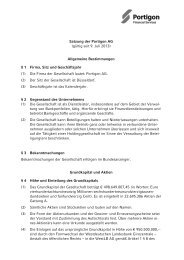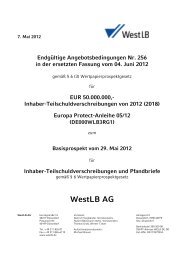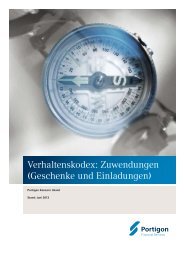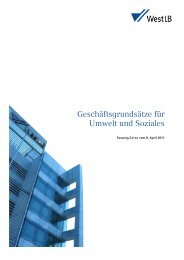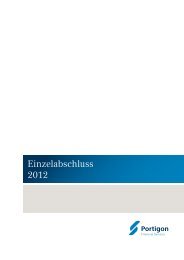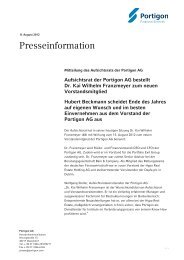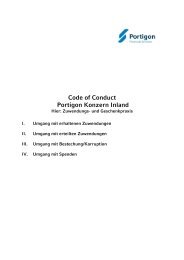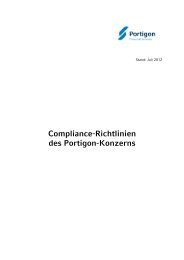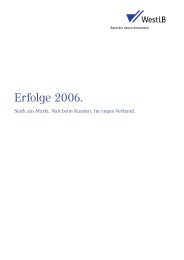pdf, 1996K - WestLB
pdf, 1996K - WestLB
pdf, 1996K - WestLB
Create successful ePaper yourself
Turn your PDF publications into a flip-book with our unique Google optimized e-Paper software.
oversees the Issuer's subsidiaries and <strong>WestLB</strong> Group companies. Both units monitor and steer the risks relating to these<br />
commitments, with particular attention paid to companies that are exposed to entrepreneurial risks.<br />
In accordance with MaK organisational and process requirements, CRM provides the market-independent second vote<br />
for all equity investments proposed by the Corporate Finance and Bank Holdings front office units.<br />
Liquidity Risks<br />
Liquidity risk is defined as the risk that a bank may not be able to meet its current and future payment obligations in full<br />
or on time, that in the case of a liquidity crisis refinancing may only be raised at higher market rates (funding risk), or<br />
that assets may only be liquidated at a discount to the market rates (market liquidity risk).<br />
The objective of liquidity management is to avoid a concentration of financing requirements with very short-term<br />
maturities, to keep enough liquid assets on hand for unexpected liquidity needs and, at the same time, to optimise the<br />
Issuer's structural liquidity with the help of a medium and long-term-oriented funding programme.<br />
Operational Risks<br />
Operational risk refers to the risk of losses resulting from inadequate or failed internal processes, people and systems or<br />
from external events.<br />
Operational Risk Management (ORM) defines the framework for managing operational risk. ORM ensures that<br />
operational risk management activities are consistent throughout the Issuer, provides an opinion on operational and<br />
reputational risk and advises the Issuer's business units.<br />
The collection of internal and external loss data, Risk Self Assessments (RSA), Risk Indicators and Scenario Analysis<br />
represent important instruments of operational risk management. In future, the regulatory capital charge for operational<br />
risk will be calculated using a recently developed quantification method that will also be deployed for internal steering.<br />
The objective is to have the method satisfy the requirements for the Advanced Measurement Approach (AMA)<br />
following Basle II as soon as possible.<br />
Factors which Are Material for the Purpose of Assessing the Market Risks Associated with Instruments Issued<br />
under the Programme<br />
The Instruments May not Be a Suitable Investment for Investors<br />
Each potential investor in the Instruments must determine the suitability of that investment in light of its own<br />
circumstances. In particular, each potential investor should:<br />
(i) have sufficient knowledge and experience to make a meaningful evaluation of the Instruments, the merits and<br />
risks of investing in the Instruments and the information contained or incorporated by reference in this DIP<br />
Prospectus or any applicable supplement thereto;<br />
(ii) have access to, and knowledge of, appropriate analytical tools to evaluate, in the context of its particular<br />
financial situation and the investment(s) it is considering, an investment in the Instruments and the impact the<br />
Instruments will have on its overall investment portfolio;<br />
(iii) have sufficient financial resources and liquidity to bear all of the risks of an investment in the Instruments,<br />
including Instruments with principal or interest payable in one or more currencies, or where the currency for<br />
principal or interest payments is different from the potential investor's currency;<br />
(iv) understand thoroughly the terms of the Instruments and be familiar with the behaviour of any relevant indices<br />
and financial markets; and<br />
(v) be able to evaluate (either alone or with the help of a financial adviser) possible scenarios for economic,<br />
interest rate and other factors that may affect its investment and its ability to bear the applicable risks.<br />
Some Instruments are complex financial instruments. Sophisticated institutional investors generally do not purchase<br />
complex financial instruments as stand-alone investments. They purchase complex financial instruments as a way to<br />
reduce risk or enhance yield with an understood, measured, appropriate addition of risk to their overall portfolios. A<br />
potential investor should not invest in Instruments which are complex financial instruments unless it has the expertise<br />
(either alone or with a financial adviser) to evaluate how the Instruments will perform under changing conditions, the<br />
resulting effects on the value of the Instruments and the impact this investment will have on the potential investor's<br />
overall investment portfolio.<br />
30



